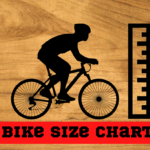Are you in search of the perfect bike but unsure about what size frame to get? It’s important to find the right fit for your height and body type so that you can ride comfortably and efficiently. In this blog post, we’ll dive into the details of a 17 inch bike frame, how to measure it properly, and tips on choosing the right sized bike for you. So whether you’re an experienced cyclist or just starting out, read on to learn more!
17 inch bike frames

When it comes to bike frames, the size is a crucial factor in determining comfort and performance. A 17-inch frame typically caters to individuals who are between 5’7″ and 5’9″ tall, but that’s not always the case. The frame’s size also depends on factors such as your inseam length, arm span, and riding style.
Here are some recommendations for these measurements for a 17 inch bike frame:
- Top Tube Length: 54-56 cm
- Stem Length: 70-90 mm
- Handlebar Width: 38-42 cm
A 17-inch bike frame is suitable for people who prefer smaller frames or have shorter legs than average. It’s also ideal for those who want a more maneuverable ride with responsive handling. However, if you’re taller or have a longer inseam length than usual, this may not be the right size for you.
It’s essential to note that different brands may vary in their sizing chart measurements. So before purchasing any bike frame online or from a local store, make sure to check their measurement guide thoroughly.
How to measure a bike frame
Measuring a bike frame is an essential step in finding the right size bike for you. To measure your bike frame, start by standing with your back against a wall and wearing shoes. Next, place a book between your legs and press it up to your crotch.
Measure the distance from the top of the book to the ground; this measurement is called inseam length. Write down this number as it will be useful when determining the correct frame size.
The most common way to measure a bike frame is center-to-top (CT). This measurement starts at the center of where the bottom bracket meets with the seat tube and ends at where that tube reaches its topmost point.
Another way to measure a bike’s frame is center-to-center (CC), which measures between two points on each side of either end of horizontal or diagonal tubing.
It’s important to note that some manufacturers may use different methods of measuring their bikes’ frames, so always refer to their specific sizing guides before making any purchases.
What size bike do I need?
Choosing the right size bike can make all the difference in your riding experience. A bike that is too small or too big for you will not only be uncomfortable but also potentially dangerous.
The first step to determining what size bike you need is to measure your inseam. This measurement will give you an idea of how much standover height you need, which is the clearance between the top tube and your body when standing over the bike.
Next, consider your riding style and goals. If you plan to ride long distances or compete in races, a smaller frame with a more aggressive geometry may be best. For leisurely rides or commuting, a larger frame with a more relaxed geometry may provide greater comfort.
It’s also important to factor in any physical limitations or injuries when selecting a bike size. If you have knee pain, for example, choosing a smaller frame with shorter reach may help alleviate discomfort.
Ultimately, finding the right size bike comes down to personal preference and comfort level. Take test rides whenever possible and consult with experts at local bike shops for guidance on sizing options.
How to choose the right sized bike
Choosing the right size bike is crucial for comfort and safety while riding. Here are a few tips to help you choose the right sized bike:
1. Measure your inseam – the distance from the floor to your crotch. This measurement will give you an idea of what frame size to look for.
2. Consider your height – along with your inseam, your height can also be a good indicator of what size bike frame you need.
3. Think about how you’ll use the bike – different types of bikes have different frame sizes based on their intended use. For example, road bikes tend to have larger frames than mountain bikes because they’re designed for speed rather than maneuverability.
4. Test ride before buying – it’s always best to test out a few different sizes and styles of bikes before making a purchase so that you can get a feel for which one suits you best.
5. Consult with a professional – if you’re still unsure about what size or type of bike is right for you, consider consulting with a professional at your local bike shop who can offer expert advice tailored specifically to your needs and preferences.
Remember that choosing the right sized bike isn’t just about getting something that looks cool or fits within your budget; it’s about finding something that feels comfortable and safe when riding so that you can enjoy all the benefits biking has to offer!
Conclusion
Choosing the right size bike frame is crucial for a comfortable and safe cycling experience. A 17 inch bike frame can be ideal for someone with an inseam measurement of about 28-31 inches. However, it is always recommended to measure your own inseam and consult with a professional or refer to a size chart before making any purchases.
Remember, different types of bikes may have slightly different sizing requirements as well. Road bikes tend to have smaller frames while mountain bikes generally need larger ones.
When in doubt, test ride different sizes of bikes before deciding on one. This will ensure that you find the perfect fit for your body type and riding style.
Investing in the right sized bike frame will not only improve your comfort but also enhance performance and prevent injuries. So take the time to do some research and measurements before hitting the road or trails on your new ride!
Also Read How big is 18 inch bike frame?






